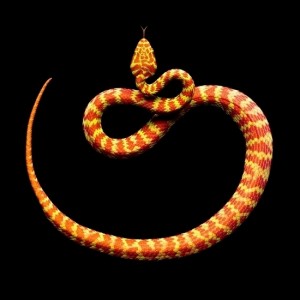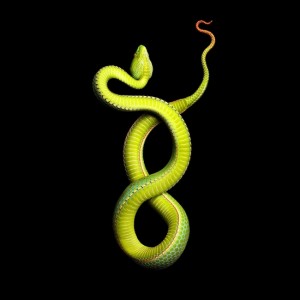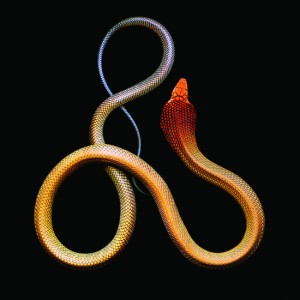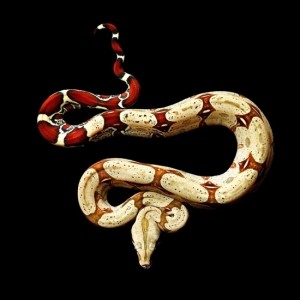—>Maegan’s post deals with the beauty and threat of snakes, as shown in iconic photos by Mark Laita at, where else, the Academy of Natural Sciences!—the Artblog editors———————————->
I am not necessarily afraid of snakes, but there is an inherent sense of danger and fear brought on by interacting with them. In seventh grade, a snake handler was invited to our science class as a guest lecturer. He brought in a large snake; the type escapes me, although I do remember that it was relatively harmless as far as snakes go. Each willing student was allowed to hold the snake. I was surprised by the weight on my shoulders; I could feel its muscles shifting as it curled itself around my arm and remember being quite uneasy.

Mark Laita’s show, “Serpentine,” comes from his book of the same name. The collection of fine art photographs of snakes aims to explore both their aesthetic and conceptual properties. I often associate snakes with the negative: images of creepy nightmares and scary scenes from movies. Beauty, in the traditional sense, is not the first thought in my mind. Laita asks his audience to reexamine snakes; to appreciate their aesthetically pleasing qualities, their power and grace.
How did he do that?
You may wonder whether these are live snakes, and if so, how the photographer captured the animals looking so gorgeous and iconic. According to the Academy, the photographer spent more than a year in Central America “photographing rare and dangerous pythons, pit vipers, coral snakes and other serpents in the care of collectors, breeders, zoos and venom laboratories.” So, these are pictures of live snakes, and apparently live snakes do curl themselves into gorgeous iconic displays. Other information: “He took the photographs right after each snake had shed its skin, so the colors would be the most vibrant.”

His subjects are photographed against a thick black background. The stark contrast of the velvety backdrop heightens the vivid colors and textures of each snake’s skin. They seem to vibrate in their frames. Laita’s photography makes these lethal reptiles seem almost approachable, although the dimly-lit room paired with the dark backgrounds of the photos and the subject itself add up to a moody and haunting experience.

The fluid movement captured in Laita’s photographs is mesmerizing: the lines are sensual. The photograph “King Cobra” really highlights its glossy skin. The shape of the cobra’s head is something immediately associated with danger, but here all I could focus on was the sultry aspect of its twisted orange-red skin. The title card informs the viewer that this breed can grow up to 18 feet in length. Pondering this size makes me feel a little anxious, imagining all of that weight and strength beneath the scaly skin.

The Malaysian Coral Snake lends a cool contrast to the Cobra; it has lovely cerulean coloring on its body and is tipped with coral color around its head and tail.
The surprise of finding an art gallery at the Academy

Before seeing this show, I hadn’t given much thought to the attractiveness of snakes. I’m not sure whether my gut reaction to them will ever change, but this show has certainly made me consider snakes for something other than raw threat and terror.
The show is held in the Academy of Natural Sciences’ Art of Science Gallery, where the institution regularly features works by contemporary artists. Each photograph is accompanied by the usual title card; printed on each are factoids about the snakes. This educational element brought something to the show: I enjoyed learning whether the subjects were venomous or constrictors and, even more so, where each snake hails from. I hadn’t been to the Academy of Natural Sciences since I was much younger, and never realized that they had a gallery on the premises. It’s wonderful that the Academy fuses science education with works by contemporary artists to expose children (and adults too) to some scientifically-themed artwork.
“Serpentine” will be on display until September 15, 2013 in the “Art of Science Gallery.” More information can be found by visiting the Academy of Natural Sciences’ website.





